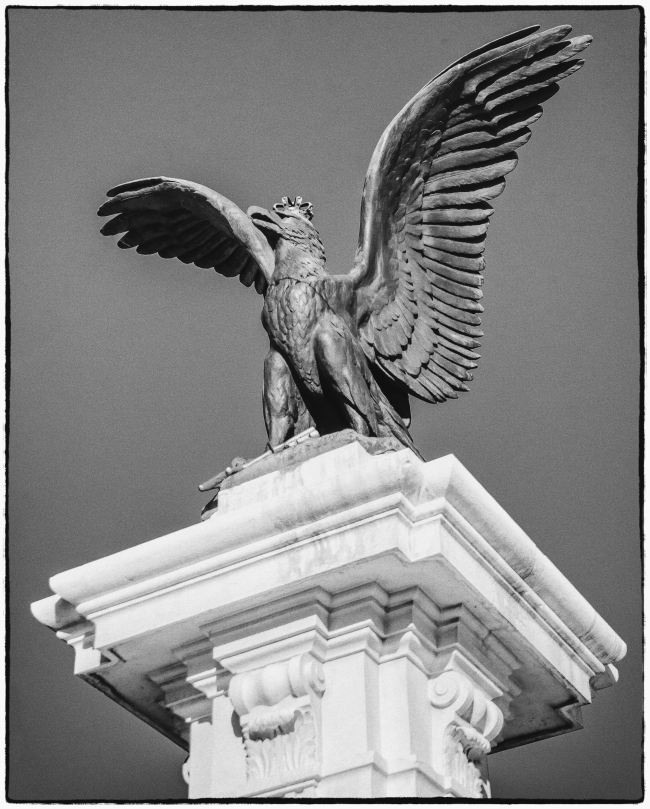This eagle is one of two such statues standing on columns on either side of the Place Neuve entrance to the Parc des Bastions.
According to the Geneva.info site:
Bastions Parc is famous for the Reformation Wall proudly standing here, big chess boards at the entrance, great restaurant and big playground for a kids. Opposite the reformation wall stands one building of the University of Geneva and it’s public library.
The main entrance to Bastions Park is from Place Neuve. Just behind the big decorated gate are huge black-white boards for playing Chess, Go and Checkers, always full of people immersed in their game, old or young. Behind the game boards is popular Restaurant and several refreshement stalls that will sweeten Your day, and behind the restaurant is hidden big adventurous playground for children with their families, offering the opportunity to spent an afternoon playing.
Parc des Bastions has lot of green lawns, big trees and open air, all making up for a beautiful park. During sunny days many people lay down on the grass or have a picnic here, others read a newspaper or browse the internet sitting on one of many benches. Oftentimes in a summer musical festivals, cultural or other events take place here and it is no rarity to see people walking a slackline sprung between the threes.
Parc Bastions has beautiful peaceful restaurant, located in a construction of former botanical glass house.
While I haven’t been able to discover who was responsible for the creation of this statue, I do know what it symbolizes. If you look closely you can see that the eagle has a crown on its head, and is clutching a key in it’s right talons. According to the Flags of the World website:
Symbolism of the flag
The eagle symbolises loftiness, justice and protection. The key symbolises ecclesiastical rule, treasuries, and responsibility. The arms of Geneva are actually two shields impaled: half the eagle of the Holy Roman Empire, and one of the two keys of St. Peter (the “keys of heaven”).
History of the flag
Geneva is one of the oldest cities in Europe, having been a Celtic capital before its conquest by the Romans in 121 BC. With the advent of Christianity, Geneva became an important and powerful bishopric. St. Peter’s Cathedral still dominates the city. After the fall of Rome, Geneva came first under Frankish control, then Burgundian, and finally the Holy Roman Empire from which the city-state gained sovereignty in 1124. Savoy made repeated attempts to annex the city until 1603 when Bern lifted the last siege. Bern and Fribourg had been allies of Geneva since 1519, and Zurich formed a perpetual alliance in 1584, but the Swiss Catholic cantons blocked Geneva’s attempt to become a full-fledged member of the Confederation. France annexed Geneva in 1793, but it regained its independence in 1813 and became the 22nd member of the restored Swiss Confederation in 1815.
The flag of the old bishopric of Geneva consisted of two gold keys on a red field, the field colour symbolising sovereignty within the Holy Roman Empire (“Blutbanner”). The earliest known example dates from 1293. In the 15th century the imperial eagle was impaled with the keys (obscuring one key and half the eagle), thus demonstrating both the city’s imperial freedom and the bishop’s sovereignty.
The full coat of arms of Geneva consists of the shield surmounted by a crest in the form of half a sun inscribed with the initials “J H S” (Jesus Hominum Salvator), and below a scrolled motto “Post Tenebras Lux” (after the darkness, light). The sun was an symbol of Geneva from earliest times, and the motto was added during the Reformation. The full coat of arms appeared as the central device on Geneva’s flamed war flag of 1815.
With the admission of Geneva in 1815, the modern Swiss Confederation assumed its current geographical shape, and remained at 22 cantons (not counting half-cantons) for the next 164 years.
Taken with a Sony RX100 M3

